- Home
- Edward Cline
Hugh Kenrick
Hugh Kenrick Read online
SPARROWHAWK
Book Two — HUGH KENRICK
*
A novel by
EDWARD CLINE
ebook ISBN: 978-1-59692-944-9
M P Publishing Limited
12 Strathallan Crescent
Douglas
Isle of Man
IM2 4NR
British Isles
Telephone: +44 (0)1624 618672
email: [email protected]
Originally published by:
MacAdam/Cage Publishing
155 Sansome Street, Suite 550
San Francisco, CA 94104
www.macadamcage.com
Copyright © 2002 by Edward Cline
ALL RIGHTS RESERVED.
Library of Congress Cataloging-in-Publication Data
Cline, Edward
Sparrowhawk—Hugh Kenrick / by Edward Cline.
41 chapters + prologue & epilogue — (Sparrowhawk; bk. 2)
ISBN: 1-931561-20-6 (alk. paper)
1. Great Britain—History—George II, 1727-1760—Fiction.
2. Young men—Fiction. I. Title: Hugh Kenrick II. Title.
e-book 2010
Book and jacket design by Dorothy Carico Smith.
Cover painting “Entrance to Fleet River” by Samuel Scott 1702—177
Publisher’s Note: This is a work of fiction. Names, characters, places, and incidents either are the product of the author’s imagination or are used fictitiously. Any resemblance to actual events, locales, or persons, living or dead, is entirely coincidental.
CONTENTS
Prologue: The Peace Makers
Chapter 1: The Brass Top
Chapter 2: The Enfants Terrible
Chapter 3: The Rebel
Chapter 4: The Heart of Oak
Chapter 5: The Extraordinary
Chapter 6: The Test
Chapter 7: The Punishment
Chapter 8: The Watershed
Chapter 9: The Portrait
Chapter 10: The Young Men
Chapter 11: The City
Chapter 12: The Apprentice
Chapter 13: The Cosmopolitan
Chapter 14: The Mohocks
Chapter 15: The Fruit Wench
Chapter 16: The Member for Canovan
Chapter 17: The Sparrowhawk
Chapter 18: The Member for Onyxcombe
Chapter 19: The Supper Room
Chapter 20: The Society of the Pippin
Chapter 21: The Toast
Chapter 22: The Peerage
Chapter 23: The Theft
Chapter 24: The Letters
Chapter 25: The Thinkers
Chapter 26: The Critics
Chapter 27: The Lovers
Chapter 28: The Olympian
Chapter 29: The Idyll
Chapter 30: The Arrests
Chapter 31: The Criminal
Chapter 32: The Examination
Chapter 33: The Crown Side
Chapter 34: The Defense Side
Chapter 35: The King’s Bench
Chapter 36: The Jury
Chapter 37: The Oath
Chapter 38: The Pillory
Chapter 39: The Lawless
Chapter 40: The Prisoner
Chapter 41: The Departure
Epilogue: The Voyage
Acknowledgments
I am indebted, first and foremost, to two individuals, no longer with us. One confirmed my approach to life, the other confirmed its direction: Ayn Rand, the novelist-philosopher, whose novels I discovered, when a teenager, in the vandalized library of a suburban Pittsburgh boys’ home; and David Lean, the British director, whose Lawrence of Arabia I saw the same year, an event that cemented my ambition to become a novelist.
Special fond thanks go to Wayne Barrett, former editor of the Colonial Williamsburg Journal, who was certain this novel would see the light of day after having read the first page long ago; and to the BookPress in Williamsburg, whose partners, John Ballinger and John Curtis, also encouraged me and allowed me to rummage through their valuable stock on the track of ideas and materials.
Further debts of thanks are owed to the staff and past and current directors of the John D. Rockefeller, Jr. Library at Colonial Williamsburg for their assistance; to many of Colonial Williamsburg’s costumed “interpreters,” too numerous to name here, for the passion, lore, and information they imparted; and to the staff of the Earl Gregg Swem Library at the College of William & Mary, Williamsburg.
Pat Walsh, editor, together with Robert Tindall and John Gray, have my gratitude for their incisive suggestions and innumerable corrections, and for sharing my confidence that this novel will find a large and appreciative readership.
Lastly, I owe a debt of thanks to the Founders for having given me something worth writing about, and a country in which to write it.
Prologue: The Peace Makers
IN JULY, 1748, THE MERCHANTMAN SPARROWHAWK WAS PILOTED UP THE York River, Virginia. Her first stop on this deep-water gateway to Chesapeake Bay and the Atlantic was Yorktown, a thriving port that boasted several piers, boatworks, tobacco and crop warehouses, palatial homes on the hill overlooking the waterfront, and, of course, several hostelries and taverns. It was one of the vessel’s last calls before she sailed farther up the York for De La Ware Town at the headwaters of the river to begin taking on cargo for the voyage back to England. She had already discharged most of her paying passengers in Charleston, South Carolina, together with most of her inanimate cargo—barrels and crates of British-made merchandise, farm and household implements, pipes and casks of various liquors, books, furniture, and even a few pieces of marble. There also her captain and part-owner, John Ramshaw, sold the indentures of the English and Huguenot redemptioners, and the indentures of his sentenced felons. In Hampton, Virginia, closer to the Bay, he had paused long enough to exchange a portion of his vessel’s ballast of Newcastle coal for one of saltpeter.
Only a few paying passengers remained on board the Sparrowhawk as she sailed up the coast to the York River. Among the men and women who filed down the gangboard with their bundles and bags at Yorktown on the hot mid-July afternoon was the McRae family. Ian McRae was the new factor for the firm of Sutherland & Bain of Edinburgh, tobacco importers, and had journeyed these three thousand miles to replace another Scotsman who had died six months before. His store was located in Caxton, Queen Anne County, another port town and tobacco collection point some miles farther up the York. McRae had brought his wife, Madeline, and their five-year-old daughter, Etáin, with him. He expected to live out the balance of his life here.
Ramshaw had other errands to run up-river, and decided to leave the Sparrowhawk in Yorktown so his crew could empty the holds of the last of the merchandise and finish proper repairs of the damage she had sustained during an encounter with a French privateer months earlier. He shared with the McRaes the cost of renting a wagon from a local merchant and rode with them to Caxton.
Accompanying him also was the one remaining felon, fourteen-year-old Jack Frake, who had seven and a half years left to serve of his sentence for smuggling in Cornwall, England. He was a hero to the McRaes and Ramshaw, for in the heat of the sea fight he had fired the swivel gun that killed the captain of the predatory French privateer and caused his crew to call off its attack. In Caxton, Ramshaw called on an old friend, county militia officer John Massie, owner of Morland Hall, a large plantation near Caxton. He introduced Jack Frake to him, and sold that man Jack’s eight-year indenture for a penny.
“Can he read, or cipher?” asked Massie, looking out his study window at the boy, who waited on the spacious porch. Sitting at Jack Frake’s feet was a bundle of possessions, including a green suit, a few things he had acquired from other passengers during the Sparrowhawk’s voyage, and so
me books that Ramshaw had given him, including a copy of a novel, Hyperborea; or, the Adventures of Drury Trantham.
“Can he read?” scoffed Ramshaw, puffing on a pipe. “My friend, he has copied out whole books, and helped me with my accounts on the way over! Found some errors I was blind to. Some day, he’ll read His Majesty and Parliament their own Riot Act, you mark my words.” He studied his host for a moment. “Treat him like a son, John, as Skelly and O’Such did, and you’ll win his loyalty. He’s rough at the edges now, but with a firm hand and some fine honing, he’ll become a devil of a man, and then there will be no stopping him! You’ll want him at your side, and on it!”
With earnest farewells and promises to meet again, Ramshaw left Jack Frake behind at Morland Hall two days later. In August the Sparrowhawk left Chesapeake Bay and sailed back into the Atlantic.
* * *
In October, 1748, French privateers were still harrying English merchantmen, even as the ink dried on the second Treaty of Aix-la-Chapelle, which formally ended the War of the Austrian Succession. Nothing momentous was settled by this treaty. The Pragmatic Sanction, established by Hapsburg Emperor Charles VI in 1720 to define the line of succession to the throne of Austria, was guaranteed, and Maria Theresa’s husband, Francis Stephen, Grand Duke of Tuscany, could more easily occupy it. Lands conquered were restored, except for Silesia, which was grudgingly ceded by Austria to Frederick’s Prussia, an article of the treaty that would contribute to the resumption of hostilities in the Seven Years’ War. Parts of Italy were added to the possessions of the Spanish Bourbons, which already included Naples and Sicily. The House of Savoy, or Sardinia, was awarded a portion of the Duchy of Milan. The Republic of Genoa, the Duchy of Modena, Bohemia, Hungary, and Holland were also signatories to the treaty. The privateers, however, were not, and for at least a year pretended to have no knowledge of the peace. When the convoys of warships and merchantmen ended, merchant captains ventured out on the high seas at their own risk. The Admiralty turned a deaf ear to stories of the privateers’ numerous depredations.
England’s only gains were some tenuous border adjustments and concessions in North America from Spain and France. These articles, including the one returning Louisbourg in Nova Scotia to the French in exchange for the return of Madras in India to the English, would serve to precipitate the Seven Years’ War as well. Assurances were also provided that the House of Hanover, to which George II belonged, and whose political status in Germany was of constant anxiety to him, would retain its right of succession in the German states and on the English throne. George II, Elector of Hanover, both feared the designs of his brother-in-law Frederick the Great on Hanover and other German states; and envied his standing army of 80,000 men. English law prevented the sovereign from having such a toy. George II was not a keen political observer, but at least he knew that a king with a large standing army at his disposal would always be tempted—even driven—to do something with it. The cost of maintaining such an instrument of power could always be offset with the conquest by it of a rich and influential state. Hanover was such a state.
The peace was a vehicle of mutual convenience for all the signatories, an extended cease-fire tacitly contrived to allow them to catch their wind before continuing the contest seven years later. No one familiar with the byzantine, treacherous tangle of Continental politics, with its maze of treaties, pacts and alliances, with its smoldering jealousies, codicilled secret agreements and xenophobic court protocols, culminating in Aix-la-Chapelle, was fooled or beguiled by the Treaty of 1748, especially not the diplomats and statesmen responsible for it. At the same time, however, everyone wished most earnestly to believe in its beneficent longevity.
As if to augur the impermanence of the peace, George II commissioned George Frederick Handel, another Hanoverian more happily and busily ensconced in London than was the sovereign, to compose music with which to publicly celebrate it, specifying that the opus employ martial themes, allow for the prominence of wind instruments, and feature as few stringed instruments as possible, preferably none. The fiddle admittedly is not a warlike instrument, and George II, hero of the battle of Dettingen and the last British monarch to lead troops into battle, wished to stress that the peace owed much to England’s military prowess, even though he withdrew his army from the conflict four years earlier to combat the Jacobite menace at home.
Handel, offended at having esthetics dictated to him, at first balked at the royal stipulations, then acquiesced, after this performance. The Duke of Montague, in the meantime, out of his own purse, had built in a corner of St. James’s Park a great Doric pavilion to accommodate one hundred musicians and from which to launch a dazzling array of Italian fireworks once the orchestra had played Handel’s overture. The pavilion, conceived by a famous Italian stage designer, was an imposing structure four hundred feet long and one hundred high, boasting plaster copies of Greek gods, a bas-relief of George II himself, and, from the center temple, a two-hundred-foot column crowned with a sunburst, in the middle of which were inscribed the words Vivat Rex. The Duke of Montague wished it to be known that, where his fealty to the king was concerned, he had no scruples, esthetic or otherwise.
A rehearsal of Handel’s Music for the Royal Fireworks—sans fireworks—was held at Vauxhall Gardens across the Thames in mid-April, 1749, and was attended by the Duke of Cumberland, hero of Culloden, for the purpose of ascertaining that the music was martial enough for his father the king’s tastes. The rehearsal attracted some twelve thousand paying subscribers, causing a three-hour traffic jam of carriages on London Bridge and a number of fights among footmen competing for their employers’ rights-of-way. A week later, on the unseasonably warm and humid evening of the 27th, the king attended the official celebration in Green Park. He, his son the Duke of Cumberland, and other notables, toured the pavilion, then retired to the nearby Queen’s Library to hear the music and observe the display. One hundred and one brass cannon were scheduled to be fired in salute to His Majesty, a sound more to his liking, perhaps, than was the overture. In a lamp-lit cordoned area facing the pavilion, lords, ladies, viscounts, and important commoners sat uncomfortably in the stifling air under special shelters to audit the event. The ladies fluttered their fans, the lords scratched their itchy hose. In the park itself, beyond the flower-bedecked railings and a cordon of grenadiers that secured the pavilion, milled many thousands more spectators.
Chapter 1: The Brass Top
IN THE PARK, BENEATH AN OAK TREE, STOOD SEVERAL GOVERNESSES AND their charges, children either too young to appreciate the select gathering at the pavilion, or too much of a care for parents distracted by the scintillating company gathered in it. With them were manservants of other families, assigned the duty of guarding the women and children from footpads and other criminals. Near the tree an altercation occurred between two of the boys, ages six and eight, just as the orchestra began to play Handel’s overture. The cause of the dispute was a top belonging to the younger of the boys, Hugh Kenrick, son of Garnet Kenrick and nephew of Basil Kenrick, the Earl of Danvers. It was coveted by the older boy, John Hamlyn, son of a Sussex baron and nephew of an important man who was a member of the king’s Privy Council.
It was a brass top, a beautiful, lustrous solid thing that hummed and that was powered by a finely made silk cord with a special brass grip on the end. Hugh’s father had bought it for him the day before in a Strand shop at his excited urging, once he espied it among all the other possibilities. Hugh Kenrick did not so much play with it as study it. He spun it over and over again and peered at it as it whirled and hummed, trying to imagine what physical properties it had and what forces were at work that caused it to sit on one end and spin so long, much longer and much more smoothly than did any of the wooden tops he had in his room at home. The hum, he had concluded, was caused by little notches artfully carved on the flat top of the tapered disk, and he had deduced that his role in its spinning ended when the cord disengaged and left the tiny hole in the shaft, leaving the thing
to turn by its own rules. He had mastered the art of launching it so that it spun on exactly the point he had set it on, instead of traveling across the floor and bumping haphazardly into things. He had also established the policy of stopping the top when it began to wobble dramatically, so that it would not topple to an ignominious end and scratch its surface. He had even turned it over and launched it upside-down so that it spun on the knob on the end of the shaft, but this was more difficult to do and it did not spin so perfectly, and so he had concluded that the weight and shape of the top governed how well it performed. It was a small thing which barely fit into the palm of his hand, and the smallest of the things he owned, but it fascinated him as nothing else ever had. He loved it and respected it.
Hugh had arrived at the park in the company of his governess and his father’s valet hours ago and joined the governesses, children, and manservants of other families. With them, also, was his mother’s wet nurse, who carried his one-year-old sister, Alice, wrapped in swaddling clothes, in a woven basket. After a while he tired of watching the endless throngs of spectators pass by the tree. He tried climbing the tree for a better view of the pavilion, but was prevented from doing so by Bridget, his governess, who was worried that he would spoil his blue suit or ruin his immaculate white wig by getting it tangled in branches, damages for which she would be held accountable. He watched the other children play games—Blind Man’s Bluff and Hot Cockles—but was not interested in joining them. Eventually he knelt in the grass not far away, took the top from his frock pocket, and launched it on a flat stone. Bridget was grateful that he could amuse himself, for now she could both keep an eye on him and trade gossip with the other governesses about their employers. Owen, the valet, had joined the manservants on the other side of the tree for a game of dice.

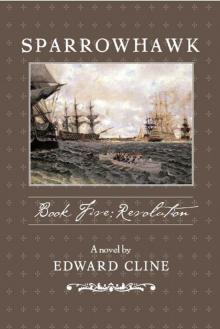 Revolution
Revolution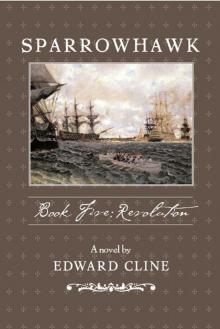 SH05_Revolution
SH05_Revolution War
War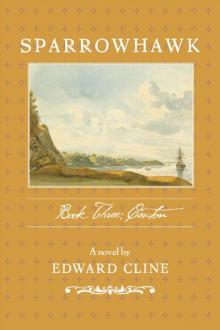 SH03_Sparrowhawk: Caxton
SH03_Sparrowhawk: Caxton Sparrowhawk III
Sparrowhawk III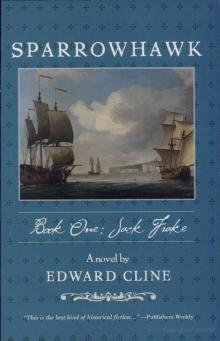 Jack Frake
Jack Frake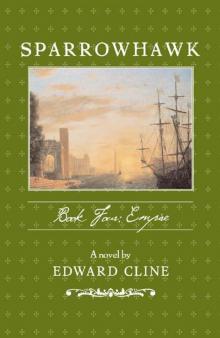 SH04_Empire
SH04_Empire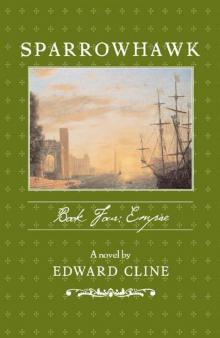 Empire
Empire SH01_Jack Frake
SH01_Jack Frake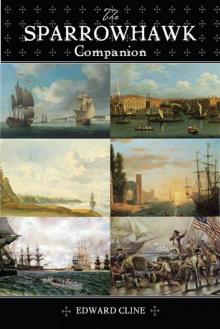 The Sparrowhawk Companion
The Sparrowhawk Companion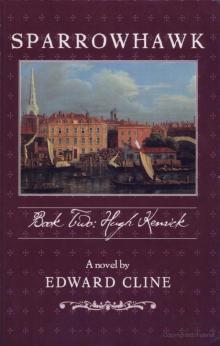 Hugh Kenrick
Hugh Kenrick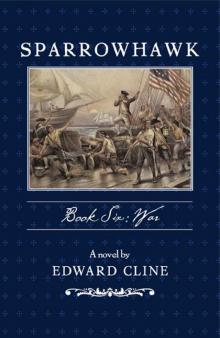 SH06_War
SH06_War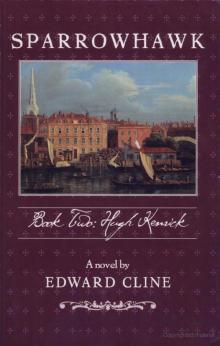 SH02_Hugh Kenrick
SH02_Hugh Kenrick